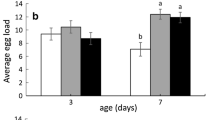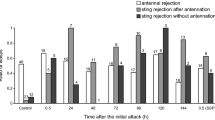Abstract
Behavioral interactions among Cotesia urabaeAustin and Allen, Dolichogenidea eucalyptiAustin and Allen (Hymenoptera: Braconidae), and their host Uraba lugensWalker, the gum leaf skeletonizer (Lepidoptera: Noctuidae), were observed at three host sizes over a 20-min period. These sizes were first instar (small, gregarious), fourth-fifth instar (mid, gregarious), sixth-seventh instar (large, solitary) larvae. Unlike C. urabae, D. eucalyptiused its legs to hold small larvae before ovipositor insertion. D. eucalyptialso visited patches of small larvae more frequently, proceeded less often through patches of mid larvae, and made significantly fewer ovipositions in mid and large larvae. Small larvae responded to both parasitoids by dispersing outward, while mid larvae responded to parasitoids by moving inward to form a denser group. Larvae reared or thrashed after each parasitoid visit, especially mid larvae, and some continued to do so for up to 2h after parasitoid departure. Mid and large larvae occasionally injured parasitoids by biting their appendages. By rearing or thrashing immediately prior to an encounter with a parasitoid, mid and large larvae decreased the likelihood of being parasitized by up to 50%.
Similar content being viewed by others
References
Allen, G. R. (1989).Behaviour and Ecology of the Primary Parasitoids Cotesia urabae and Dolichogenidea eucalypti (Hymenoptera: Braconidae) and Their Host Uraba lugens (Lepidoptera: Noctuidae), Ph.D. thesis, University of Adelaide, Adelaide.
Allen, G. R. (1990a). The phenologies ofCotesia urabae, Dolichogenidea eucalypti (Hymenoptera: Braconidae) and their hostUraba lugens (Lepidoptera: Noctuidae) in the Adelaide region.Aust. J. Zool. 38 (in press).
Allen, G. R. (1990b).Uraba lugens Walker (Lepidoptera: Noctuidae): Larval survival and parasitoid biology in the field in South Australia.J. Aust. Entomol. Soc. 29 (in press).
Arthur, A. P. (1981). Host acceptance by parasitoids. In Nordlund, D. A., Jones, R. L., and Lewis, W. J. (eds.),Semiochemicals, John Wiley and Sons, New York, pp. 97–120.
Awan, M. S. (1985). Anti-predator ploys ofHeliothis punctiger (Lepidoptera: Noctuidae) caterpillars against the predatorOechalia schellenbergii (Hemiptera: Pentatomidae).Aust. J. Zool. 33: 885–890.
Campbell, K. G. (1962). The biology ofRoeselia lugens (Walk.), the gum-leaf skeletonizer moth, with particular reference to theEucalyptus camaldulensis Dehn. (river red gum) forests of the Murray Valley region.Proc. Linn. Soc. N.S.W. 87: 316–338.
Cornell, J. C., Stamp, N. E., and Bowers, M. D. (1987). Developmental change in aggregation, defence and escape behavior of buckmoth caterpillars,Hemileuca lucina (Saturniidae).Behav. Ecol. Sociobiol. 20: 383–388.
Cott, H. B. (1940)Adaptive Coloration in Animals, Methuen, London.
Edmunds, M. (1974).Defence in Animals, A Survey of Anti-Predator Defences, Longman, Essex.
Eisner, T. (1970). Chemical defense against predation in arthropods. In Sondheimer, E., and Simeone, J. B. (eds.),Chemical Ecology, Academic Press, New York, pp. 157–217.
Fujisaki, K. (1975). Breakup and re-formation of colony in the first-instar larvae of the winter cherry bug,Acanthocoris sordidus Thunberg (Hemiptera: Coreidae), in relation to the defence against their enemies.Res. Popul. Ecol. 16: 252–264.
Gardner, S. M., Ward, S. A., and Dixon, A. F. G. (1984). Limitation of superparasitism byAphidius rhopalosiphi: A consequence of aphid defensive behaviour.Ecol. Entomol. 9: 149–155.
Genstat (1987).Genstat 5: Reference Manual, Oxford University Press, Oxford.
Ghent, A. W. (1960). A study of the group-feeding behaviour of larvae of the jack pine sawfly,Neodiprion pratti banksianae Roh.Behaviour 16: 110–148.
Hofsvang, T., and Hagvar, E. B. (1986). Oviposition behaviour ofEphedrus cerasicola (Hym.: Aphidiidae) parasitizing different instars of its aphid host.Entomophaga 31: 261–267.
Hopper, K. R. (1986). Preference, acceptance and fitness components ofMicroplitis croceipes (Hymenoptera: Braconidae) attacking various instars ofHeliothis virescens (Lepidoptera: Noctuidae).Environ. Entomol. 15: 274–280.
Hopper, K. R., and King, E. G. (1984). Preference ofMicroplitis croceipes (Hymenoptera: Braconidae) for instars and species ofHeliothis (Lepidoptera: Noctuidae).Environ. Entomol. 13: 1145–1150.
Lewis, W. J., and Vinson, S. B. (1971). Suitability of certainHeliothis as hosts for the parasiteCardiochiles nigriceps. Ann. Entomol. Soc. Am.64: 970–972.
Lloyd, D. C. (1940). Host selection by hymenopterous parasites of the mothPlutella maculipennis Curtis.Proc. R. Soc. London Ser. B 128: 451–484.
McFarland, N. (1978). Retention of cast head capsules by some nolid immatures in four old world countries.J. Res. Lepid. 17: 209–217.
Morgan, F. D., and Cobbinah, J. R. (1977). Oviposition and establishment ofUraba lugens (Walker), the gum leaf skeletoniser.Aust. For. 40: 44–55.
Morrow, P. A., Bellas, T. E., and Eisner, T. (1976).Eucalyptus oils in the defensive oral discharge of Australian sawfly larvae (Hymenoptera: Pergidae).Oecologia (Berl.) 24: 193–206.
Myers, J. H., and Smith, J. N. M. (1978). Head flicking by tent caterpillars: A defensive response to parasite sounds.Can. J. Zool. 56: 1628–1631.
Noble, L. W., and Graham, H. M. (1966). Behavior ofCampoletis perdistinctus (Viereck) as a parasite of the tobacco budworm.J. Econ. Entomol. 59: 1118–1120.
Pulliam, R. H., and Caraco, T. (1984). Living in groups: Is there an optimal group size? In Krebs, J. R., and Davies, N. B. (eds.),Behavioural Ecology: An Evolutionary Approach, 2nd ed., Blackwell, Oxford, pp. 122–147.
Risebrow, A., and Dixon, A. F. G. (1987). Nutritional ecology of phloem feeding insects. In Slansky, F., Jr., and Rodriguez, J. G. (eds.),Nutritional Ecology of Insects, Mites, Spiders, and Related Invertebrates, John Wiley and Sons, New York, pp. 421–448.
Robinson, N. H. (1969). The defensive behaviour of some orthopteriod insects from Panama.Trans. R. Entomol. Soc. Lond. 121: 281–303.
SAS (1985).SAS User's Guide: Statistics, Version 5 Edition, SAS Institute Inc., Cary, N.C.
Schmidt, G. T. (1974). Host-acceptance behavior ofCampoletis sonorensis towardHeliothis zea.Ann. Entomol. Soc. Am. 67: 835–844.
Seymour, R. S. (1974). Convective and evaporative cooling in sawfly larvae.J. Insect Physiol. 20: 2447–2457.
Slansky, F., Jr., and Panizzi, A. R. (1987). Nutritional ecology of seed-sucking insects. In Slansky, F., Jr., and Rodriquez, J. G. (eds.),Nutritional Ecology of Insects, Mites, Spiders, and Related Invertebrates, John Wiley and Sons, New York, pp. 283–320.
Stamp, N. E. (1982). Behavioral interactions of parasitoids and Baltimore checkerspot caterpillars (Euphydryas phaeton).Environ. Entomol. 11: 100–104.
Stamp, N. E. (1984). Interactions of parasitoids and checkerspot caterpillarsEuphydryas spp. (Nymphalidae).J. Res. Lepid. 23: 2–18.
Stamp, N. E. (1986). Physical constraints of defense and response to invertebrate predators by pipevine caterpillars (Battus philenor: Papilionidae).J. Lepid Soc. 40: 191–205.
Sullivan, C. R., and Green, G. W. (1950). Reactions of larvae of the eastern tent caterpillar,Malacosoma americanum (F.), and of the spotless fall webworm,Hyphantria textor Harr., to pentatomid predators.Can. Entomol. 82: 52.
Sullivan, C. R., and Wellington, W. G. (1953). The light reactions of larvae of the tent caterpillars,Malocosoma disstria Hbn., M. americanum (Fab.), andM. pluviale (Dyar).Can. Entomol. 85:297–310.
Tautz, J., and Markl, H. (1978). Caterpillars detect flying wasps by hairs sensitive to airborne vibration.Behav. Ecol. Sociobiol. 4: 101–110.
Taylor, A. D. (1988). Host effects on functional and ovipositional responses ofBracon hebetor.J. Anim. Ecol. 57: 173–184.
Tostowaryk, W. (1971). Relationship between parasitism and predation of diprionid sawflies.Ann. Entomol. Soc. Am. 64: 1424–1427.
Tostowaryk, W. (1972). The effect of prey defense on the functional response ofPodisus modestus (Hemiptera: Pentatomidae) to densities of the sawfliesNeodiprion swainei andN. pratti banksianae (Hymenoptera: Neodiprionidae).Can. Entomol. 104: 61–69.
Treherrne, J. E., and Foster, W. A. (1981). Group transmission of predator avoidance behavior in a marine insect: The Trafalgar effect.Anim. Behav. 29: 911–917.
van Lenteren, J. C. (1981). Host discrimination by parasitoids. In Nordlund, D. A., Jones, R. L., and Lewis, W. J. (eds.),Semiochemicals, John Wiley and Sons, New York, pp. 153–179.
Vinson, S. B. (1975). Biochemical coevolution between parasitoids and their hosts. In Price, P. W. (ed.),Evolutionary Strategies of Parasitic Insects and Mites, Plenum Press, New York, pp. 14–48.
Weseloh, R. M. (1974). Host recognition by the gypsy moth larval parasitoid,Apanteles melanoscelus.Ann. Entomol. Soc. Am. 67: 585–587.
Author information
Authors and Affiliations
Rights and permissions
About this article
Cite this article
Allen, G.R. Influence of host behavior and host size on the success of oviposition ofCotesia urabae andDolichogenidea eucalypti (Hymenoptera: Braconidae). J Insect Behav 3, 733–749 (1990). https://doi.org/10.1007/BF01065962
Accepted:
Issue Date:
DOI: https://doi.org/10.1007/BF01065962




